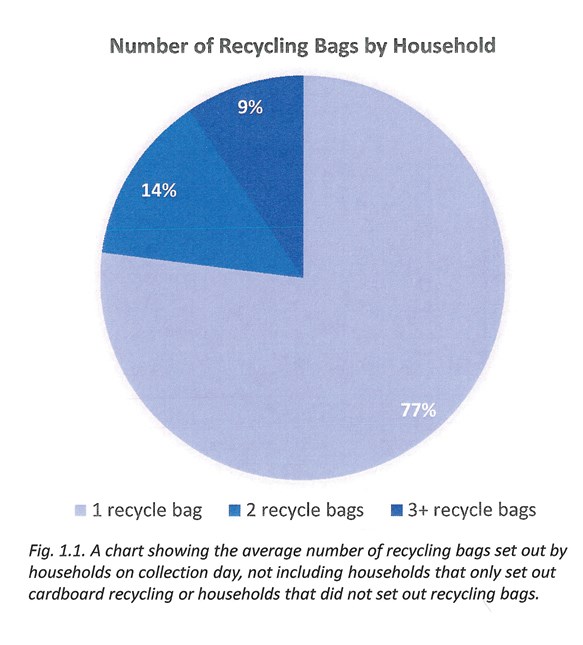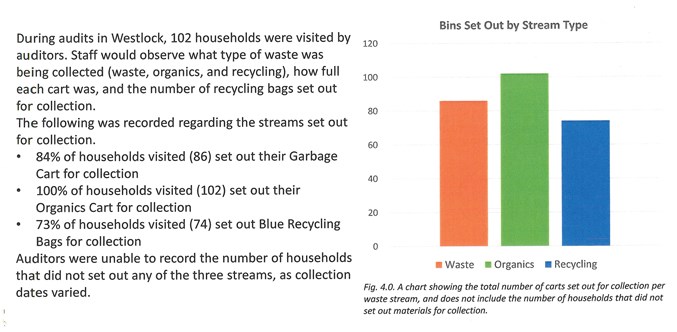Revisions to what the Town of Westlock’s contracted waste collector considers recyclable will lead to a new list of items residents will be able to place in their blue recycling bags next year.
That probable change, along with the results of a 102-household waste audit performed by GFL Environmental in the summer, as well as other possible service-level adjustments were discussed by town councillors at their Nov. 20 committee of the whole meeting.
Ultimately, councillors voted 4-0 to accept the audit as information and then asked administration to gather information via GFL on recycling/waste collection programs in neighbouring municipalities. Councillors David Truckey, Murtaza Jamaly and Clem Fagnan were absent.
Town CAO Dwight Dibben told councillors that the biggest change to the recycling schedule will involve plastic containers. In addition to mixed paper/paperboard, tin cans and deposit items like pop and beer cans, plastic containers with a recycle symbol and marked 1-7 can currently be added to the bags.
And although GFL continues to collect those plastics, containers marked 3-7 aren’t being recycled due to changes in the global recycling market, said Dibben.
Plastic bags, straws, plastic utensils and Styrofoam aren’t on the current town/GFL recyclable list.
“We know GFL is one of a few companies that have managed to carve out a bit of a market in China, but any product they ship is subject to inspection both at Canadian port, Chinese port and subject to refusal in China and then shipped back to North America at their expense,” said Dibben. “Certainly, the economics of recycling from GFL’s perspective has changed as has the content of recycling and what is being taken for recycling purposes.”
What do the numbers mean?
Developed in 1988 by the Society of the Plastics Industry, the ASTM International Resin Identification Coding System (RIC) is a set of symbols appearing on plastic products that identify the resin out of which it is made.
Type 1, polyethylene terephthalate, is often found in disposable food and drink containers including water bottles, pop bottles, vegetable oil containers, salad dressing bottles and some prepared frozen food containers.
Type 2, high-density polyethylene, is a hard plastic and visibly different from polyethylene terephthalate as it is not transparent. It is usually found in things like shampoo bottles and yogurt containers.
Type 3, polyvinyl chloride, is widely considered the most toxic and hazardous plastic and is typically used in toys, take-out food containers and non-food packaging like blister wrap.
Type 4, low-density polyethylene, is the most widely used family of plastics in the world and covers all forms of bags, food storage containers and container lids.
Type 5, polypropylene, is generally stiffer and more heat resistant so it’s often used for containers filled with hot food. Products include straws, bottle caps, Rubbermaid and other opaque plastic containers.
Type 6, polystyrene, is commonly associated with the trade name Styrofoam food containers and packing peanuts. Typical uses include egg cartons, disposable cups and bowls and take-out food containers. Harder clear/opaque polystyrene includes disposable cutlery and razors.
Type 7 does not identify one particular plastic resin and is a general catch-all for all plastics other than those identified by numbers 1-7. It can include plastics that may be layered, or a mixture of various plastics and includes new bioplastics. Uses include water bottles, three- and five-gallon water storage containers and oven-baking bags. It’s also used in custom packaging, eye glass lenses, dental sealants, car parts, computers and power tools.
“In the case of Westlock they (types 3-7) are still being picked up in the blue bags, but in essence they are not being sent to be recycled and are ending up in landfills,” said Dibben, noting the town’s agreement with GFL expires at the end of 2019 and the two will be meeting in the coming weeks.
Dibben also told councillors GFL is asking for additional $35 per tonne for collection from all municipalities, an increase they haven’t accepted.
“We are getting more information from GFL just in terms of our community, what some of the actual hard numbers are in terms of recycling and we’re going to have a follow-up conversation with GFL in terms of the fees and options.
“From our perspective if our recycling program is changing, our agreement specifies what those materials are and the fees. But if we going to be receiving a different service, and I would argue a lesser service on the recycling side, our expectation would be that there is some change in fees to our favour.”
Audit numbers
 Seventy-seven per cent of the 70-plus homes surveyed set out at least one recycling bag for collection.
Seventy-seven per cent of the 70-plus homes surveyed set out at least one recycling bag for collection.
According to GFL’s 102-home audit, conducted in the summer, 73 per cent set out weekly recycling bags.
Of those, 77 per cent set out one bag, while 14 per cent placed two and nine per cent set out three. The most common sorting errors were the placement of soft plastics like shopping and Ziploc bags and Styrofoam — soft plastics were found in 10 bags, while Styrofoam was found in two.
“People want to recycle. Whatever we do here we want to make sure we don’t lose momentum on what we’ve gained. It’s important to figure out a game plan so we don’t lose people,” said Coun. Curtis Snell, who along with Coun. John Shoemaker represent the town on the Westlock Regional Waste Management Commission.
And as both Dibben and Snell pointed out, when an item is subtracted from the blue bag, it will be added to garbage cart.
According to GFL’s audit, 39 per cent of the garbage carts were less than 25 per cent full, while 19 per cent were 26 to 50 per cent full. Fourteen per cent were 51 to 75 per cent full, while 28 per cent were at 76 to 100 per cent.
“I think it’s undeniable that with recycling program changes you’re going to see an uptake in your garbage carts. I think service and frequency is a very valid and necessary part of the discussion if we are seeing changes necessitated in recycling collection — not that these materials aren’t recyclable, but they’re not going to be collected as recyclables by our vendor at some point in the very near future,” said Dibben.
What also plays a part in the overall picture is the success of the organics bin program, which ran from May until the end of October.
All the surveyed households used their carts — 24 per cent were 76 to 100 per cent full, while 29 per cent were 51 to 75 per cent full. Twenty-four per cent were 26 to 50 per cent full and 23 per cent were less than a quarter full.
The program accepted general food and yard waste, as well as some paper and wet, or soiled cardboard, floor sweepings, saw dust and pet waste, in compostable bags.
“The question then becomes what can be offset with an organics program if there was a different frequency year-round? We’ve been told by GFL that a number of municipalities do indeed continue with year-round organics collection, but the frequency is far different from the peak months, which are spring and summer,” said Dibben.
“With this data of our service, service levels and the usage this may also be an opportunity to contemplate a different service level mix for waste, recycling and organics.”



